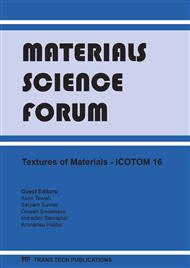p.888
p.892
p.896
p.900
p.904
p.908
p.912
p.916
p.920
TEM Studies on the Microstructural Changes during Thermo-Mechanical Cycling of NiTi Shape Memory Alloy Wire
Abstract:
NiTi based shape memory alloys (SMAs) have been identified as potential candidates for sensors and actuators in various industrial applications. During service life of actuators, SMAs are subjected to large number of stress/strain cycles through the complete transformation range, known as thermomechanical cycling (TMC), which introduces various defects in the material. In the present study, an attempt has been made to understand the microstructural changes taking place during thermo-mechanical cycling of NiTi wires using Transmission Electron Microscope (TEM). These microstructural observations have been discussed in conjunction with the cyclic shape memory behavior of the wires.
Info:
Periodical:
Pages:
904-907
Citation:
Online since:
December 2011
Price:
Сopyright:
© 2012 Trans Tech Publications Ltd. All Rights Reserved
Share:
Citation:


